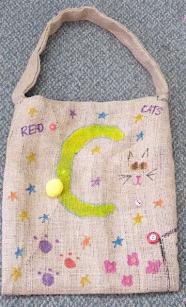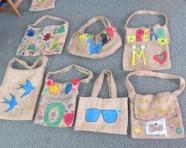Recycling coffee sacks: Integrating technology and art
Teaching inquiry
How can I integrate the technology and the art learning area into a topic with a focus on textiles? What literacy learning can I build into this?

Strategy
Recycling coffee sacks into library reading bags provided a fun and engaging technological practice project for a year 6 class.
This project provided an effective context for developing:
- technological products component understandings
- outcome development and evaluation understandings
- technology and values understandings
- art curriculum understandings
- literacy.
These slides provide an introduction to the project and the process:
Select the headings below to read more about the recycling coffee sacks project:
Technology learning area
The technology learning area component focus for this unit was technological products. The teacher Dorothy Hutton decided to also assess against outcome development and evaluation because creating the reading bag provided useful evidence for this component.
To explore these components, follow the links below:
- Technological products component
- Outcome development and evaluation component
- Technological products indicators of progression
- Outcome development and evaluation indicators of progression
Tracking coverage and learning across school
Read about the long-term implementation plan Columba College has for the technology learning area.
Links to literacy, the arts, and values
 Literacy
Literacy

Reading:
- Finding and learning the meanings of unknown vocabulary by using strategies such as applying their knowledge of how words work or seeking explanations in the text or in illustrations .
The Literacy Learning Progressions, By the end of year 6
 The arts
The arts

Developing practical knowledge:
- Explore some art-making conventions, applying knowledge of elements and selected principles through the use of materials and processes.
Technology and values

Dorothy made links between technology and values throughout the development and evaluation of the library bags made from recycled coffee sacks.
Students persevering to produce a worthwhile outcome
Students had to learn and master backstitch and hemming stitch, together with measuring and cutting a pattern based on each child's specifications in their brief.
Some children had to do lots of undoing and restitching. Some even had to recut their materials.
Technological practice leading to creative and innovative ideas
Students could make their own bag shape. One student inserted a gusset/channel and had a gathered top, others had small or big bags, wide or narrow, long or short, and so on. Students also had the opportunity to create their own stencils for the fabric art.
Ensuring fitness for purpose
It was very important that students used recycled material, and Dorothy provided the knowledge about the coffee sacks.
Technological products understandings

Researching materials
The students researched hessian as a material and explored different ways that yarns are manipulated into fabrics, including knitting and weaving. Some students knew through their own experience that knitting is a process for making fabric.
The students examined their own clothing to identify knitted and woven fabrics. Dorothy brought a rug from home that had been hooked. This showed the students another way of manipulating yarns into a material.
They created a class display of other technological outcomes, including a helmet and a shoe, a school desk, a cup, and nachos. The students were asked to identify:
- the materials in the outcomes
- why the materials were chosen
- feasible ways to manipulate the materials.
Dorothy provided a vocabulary bank.
These activities reflect the teacher guidance given in the indicators of progression for teaching the technological products component at level 1 and 2.
Attributes of the library bag
A prototype tote bag was made by a parent using a “do-it-yourself” pattern from the Internet. This bag, the pattern, and the fabric it was made from were used to initiate discussions on patterns and the requirements for the library bags.
One of the attributes of the library bag was that it needed to include decorative images and fabric art. They discussed the fact that hessian was a natural fabric (rather than the synthetic fabric used in the prototype) and would take the type of fabric paint available in class.
The class examined existing library bags and took photos. The students noticed different style features – some had a gusset, the size and type of straps differed, closure types varied, and one bag used elastic to close it. They also looked into the construction of the bags and understood that a gusset would involve extra sewing.
Functional modelling understandings

Bag size and shape
Each student collected a set of books they would consider taking out from the library. They measured the books, measured existing reading bags, and calculated the finished size needed to fit their book collection.
Each student created an initial drawing as a functional model of their proposed bag.
Dorothy taught the students how to measure and make allowances for seams and hems. They used these measurements on their functional model drawings to create a pattern out of newspaper. Then they sellotaped the pattern pieces together to create functional models.
The functional models were used to test whether the shape and size of each design would work. After testing, the students used the pieces of newspaper for patterns.
Strap width and length
The students spent time measuring and thinking about the strap width and length they wanted for their bags and creating a pattern piece for this. Dorothy observed students sitting on the mat discussing their straps and measuring and working out what they required for their bag.
Further functional modelling was carried out once they had made their strap. They pinned the strap on the bag and then tested whether it was a comfortable length to carry their bags.
Activities and skills

Dorothy purchased the coffee sacks from a roasting company that imports coffee beans. She found that one sack provided enough material for two bags.
The students assisted with unravelling the bags and then pulled threads to ensure a straight grain line for cutting out their patterns. The students cut out their own bags.
Stencils were then designed, created, and applied to the cut-out pieces of the bag. Textile paint was used for printing.
The students were shown how to do back stitch – using hessian from the sacks as thread.
They learnt to undo and that stitches that were too big made massive gaps and would not hold the bag pieces together. With practice, their stitching was superb!
Dorothy Hutton
The students also learnt about pinning seams and hems and how helpful ironing (carried out by Dorothy) is in preparing hems to ensure an accurate and even finish.
Dorothy hot glued the completed straps onto the bags because the layers of fabric were too thick for the students to join with hand stitching.
Some of the students added pockets for bookmarks and also created closures with buttons and hessian string. Others used raffia to stitch designs.
Outcomes
Library bags

Students tested their completed bags and evaluated their outcomes against the final brief. They now use their bags regularly for carrying their library books.
The bags were displayed for "Open Week" in the school office and in the library. The displays included an explanation of what they were doing in technology. The students also modelled the bags at assembly.
Technology learning area understandings
The students were mostly at level 2 for both outcome development and evaluation and technological products.
Dorothy also extended some of the students to consider the level 3 concept of technically feasible:
- describe how the properties combine to ensure the materials allow the product to be technically feasible and socially acceptable.
Here is an example of a student's response to an activity on this concept:
Recycling coffee sacks: Failed technological products (PDF, 95 KB)
Reflections
Students' reflections
The students completed a “De Bono” thinking hats reflection. Here are some of their comments, in the “Red Hat”, on what they enjoyed:
Recycling coffee sacks: Students' reflections (PDF, 38 KB)
Teacher reflections
I find once I am clear on the curriculum focus for a unit I then identify a project that will work well for an integrated focus. In this instance, we were able to add in outcome development and evaluation as well as technological products because they both had a natural fit to the project.
Dorothy Hutton
There will be the components that are the focus for assessment but technology projects will often provide opportunities for developing understandings of other components. Technological modelling, brief development, and planning were all touched on during this project.
And of course the technology learning area is a rich vehicle for other curriculum areas!


